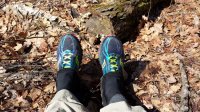chriscebal2000
New Member
- Joined
- Apr 15, 2015
- Messages
- 1
I'm new to backpacking but my fiancé and i are planning a week long trip to yosemite. I read an article that said that most experienced backpackers prefer to use running shoes instead of hiking boots. I was wondering if I could get some input before I invest in some expensive boots. Thanks!


